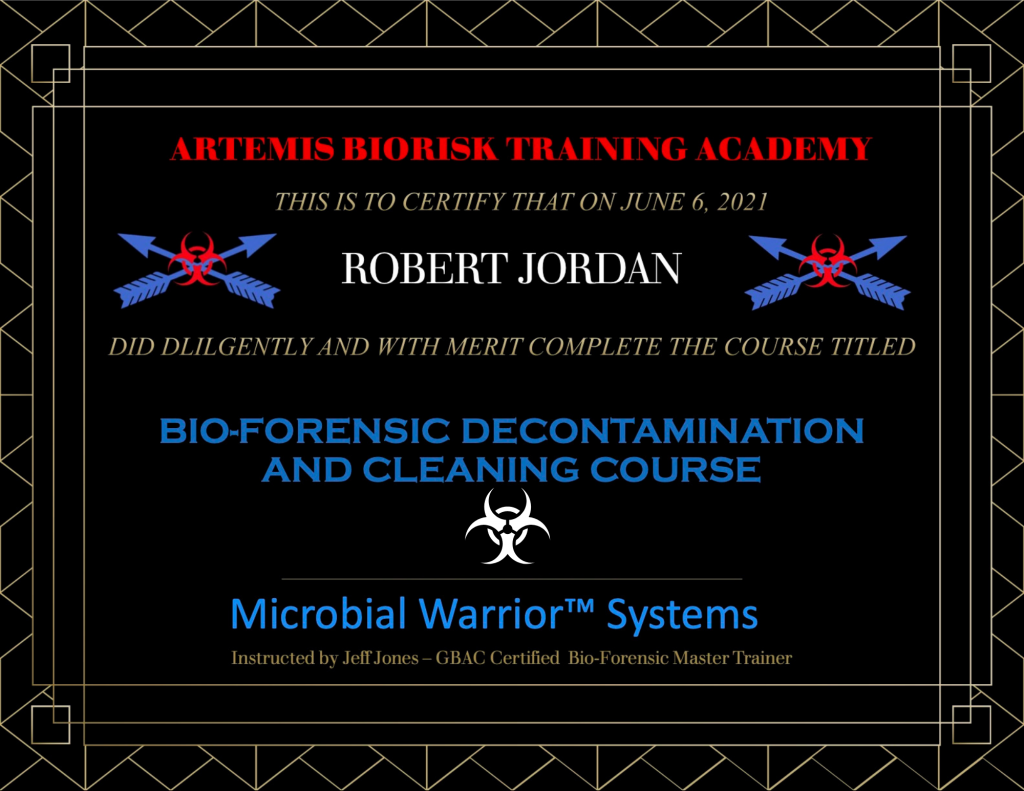

PuroClean restoration professionals are licensed, insured, and certified to remediate biohazard environments safely and follow all applicable laws and standards. We understand that some events may be sensitive and must be handled with compassion and discretion. We bring a sense of calm back to those impacted, whether the loss is in a home, commercial property, or business office.
We Are Proud to Be Certified

Biohazard remediation involves cleaning, applying EPA-approved hospital-grade disinfectants, and deodorizing areas where a traumatic event such as an accident, injury, or death has occurred. Thus, dealing with biohazards often means working with blood, human or animal remains, chemical spills, and more.
Bear in mind that state employees aren’t required to clear crime locations. When Police and investigators are finished gathering their evidence, the burden falls to the property owner to arrange biohazard cleaning professionals. So, only after the authorities have collected all evidence and have released the scene will biohazard cleanup technicians start their work.
Commonly known as “crime and trauma scene cleaning,” forensic restoration is the comprehensive cleaning and remediation of buildings and structures contaminated or suspected of contamination from biological materials.
Site and risk assessments need to be completed that start with the initial contact, acquiring critical incident data: the who, what, when, where, and how, which begins to lay the foundation of knowledge that helps forensic operators to prepare physically, mentally, and even spiritually to perform at a top tier level. We determine the scope of work from our incident site/risk assessment.
We at PuroClean of Tacoma East have been certified as Bio-Forensic Restoration Specialist® which includes:
In 1991, the Occupational Safety and Health Administration (OSHA) issued a standard to protect working individuals from the risk of blood or other possibly infectious materials (BOPIM). Infectious pathogens include the Hepatitis B virus, HIV, the 2019 Novel coronavirus (COVID-19), and numerous others.
This standard covers an estimated 5.6 million workers in the healthcare industry and related occupations. The biohazard restoration and cleaning industry are also covered under the BOPIM standard.
Additionally, the BOPIM standard includes several prerequisites, as follows:
Each time technicians handle potentially hazardous items, they do so at considerable risk. Thus, following correct proper training and safety procedures are crucial. This is necessary for their own personal safety and for the individuals who will live or work on the property after the biohazard remediation is complete.
OSHA – biohazard technicians are obligated to wear appropriate PPE while working around bloodborne pathogens. To help ensure the safety of our employees, we use PPE as the final barrier of defense. PPE (Personal Protective Equipment) protects the body from coming into contact with hazardous items via the skin, eyes, mouth, nose, or other body parts. PPE-specific items change depending on the job but should always consist of cut-resistant and nitrile gloves, a full face guard, appropriately designated waterproof coveralls, and a respirator.
Reputable remediation companies provide biohazard restoration training for employees. Learning OSHA’s on-the-job safety processes for handling biohazard waste is a significant part of the training. The technician’s training greatly lessens the risk of potential lawsuits and injuries from accidents.
As with any property damage, PuroClean remediation professionals ensure that any actions do not worsen your feeling of loss to the property managers or property owners. So, PuroClean proprietors and technicians are exceptionally sensitive, understanding that those involved can be emotionally fragile. When dealing with this type of restoration, it is important always to show additional care and compassion. PuroClean technicians empathize with all materially focused individuals dealing with these traumatic situations.
PuroClean’s RapidDefense™ is the most effective way to clean, including using EPA, approved hospital-grade disinfectants in public areas. Our system helps prevent the spread of pathogen-based illnesses, such as Influenza, Norovirus, and the 2019 Novel coronavirus (COVID-19). The process also uses Environmental Protection Agency-registered, safe products to give up to three months of barrier against pathogens. Contact us before an outbreak occurs to assist you in creating a clean atmosphere.
If your property requires biohazard cleanup and remediation, contact PuroClean and our team of technicians to thoroughly clean and restore your contaminated areas. PuroClean technicians will sufficiently restore your contamination and damage using state-of-the-art techniques and equipment.
The quality of PuroClean’s remediation services, the speed at which we deliver them, and the empathy we demonstrate throughout the process make PuroClean your perfect damage restoration company. Thus, we pledge to do whatever it takes to fully clean, remediate, and rescue properties in our communities.
Cleaning using hospital-grade disinfectants of frequently touched objects and surfaces are the suggested actions to prevent the spreading of respiratory diseases like coronavirus. However, PuroClean cannot guarantee the prevention of the spread of the coronavirus through its cleaning services. This is because the virus can re-contaminate any surface. Furthermore, the coronavirus is also spread person-to-person. So, visit the Centers for Disease Control and Prevention (https://www.cdc.gov/coronavirus/2019-ncov/index.html) for more information regarding coronavirus, its spread, and prevention.
Bloodborne pathogens (BBPs), as defined by the Occupational Safety and Health Administration (OSHA), means pathogenic microorganisms that are present in human blood and can cause disease in humans. These pathogens [...]
Biohazards are any biological contaminants such as those found in sewage, mold, or any viral or bacterial contamination such as MRSA. Biohazards also include toxins found in decaying organisms, as well as [...]
Blood itself is not a biohazard, it’s what may be in the blood that is potentially hazardous, such as bloodborne pathogens (BBPs) or infectious microorganisms, that can cause diseases. [...]
When a biohazard occurs, professionals are needed to clean and disinfect as improper treatment can spread contamination and lead to illness or life-threatening conditions. [...]
When a biohazard occurs, professionals are needed to clean and disinfect as improper treatment can spread contamination and lead to illness or life-threatening conditions. [...]